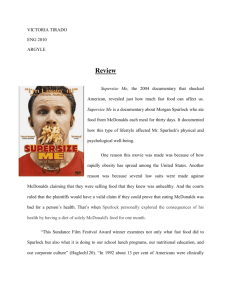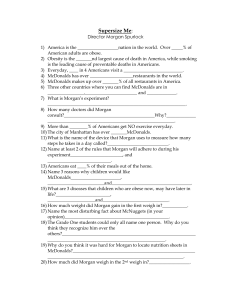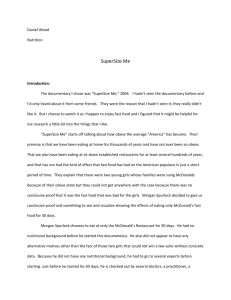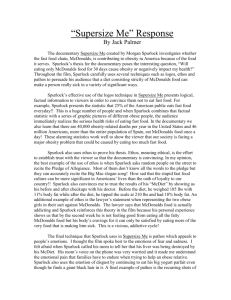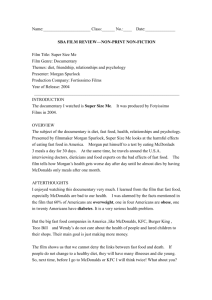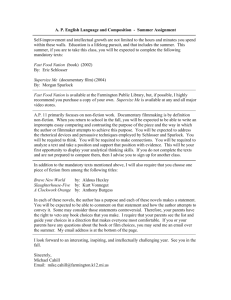Colleen Fitzpatrick Period 7 March 17th “Supersize Me” Essay
advertisement
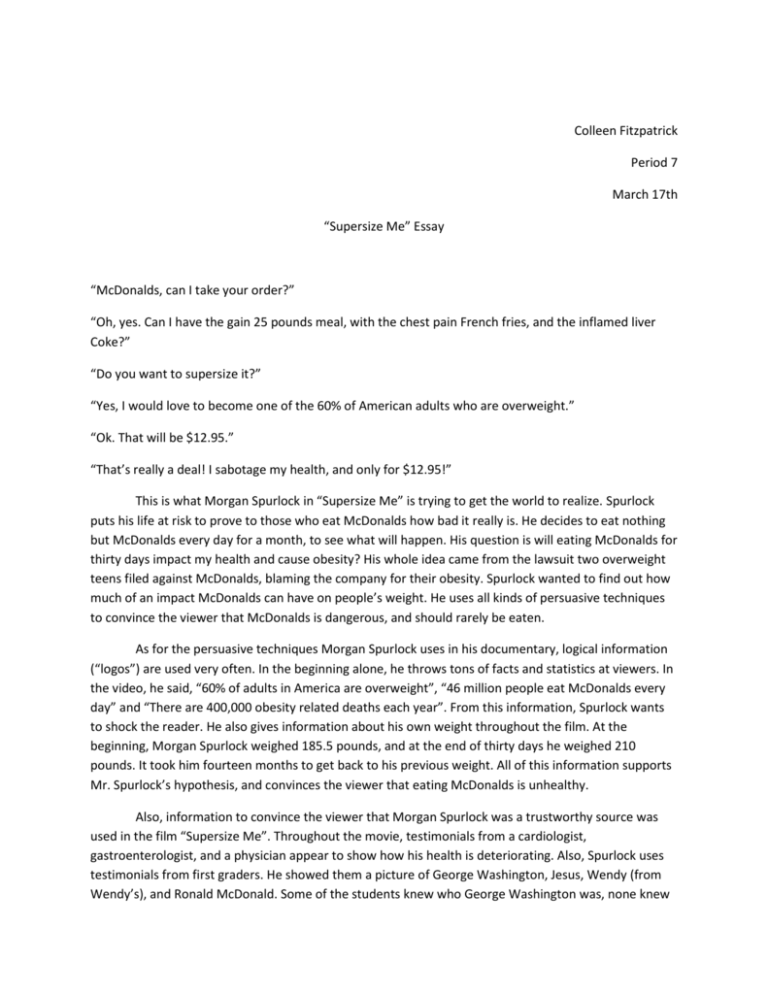
Colleen Fitzpatrick Period 7 March 17th “Supersize Me” Essay “McDonalds, can I take your order?” “Oh, yes. Can I have the gain 25 pounds meal, with the chest pain French fries, and the inflamed liver Coke?” “Do you want to supersize it?” “Yes, I would love to become one of the 60% of American adults who are overweight.” “Ok. That will be $12.95.” “That’s really a deal! I sabotage my health, and only for $12.95!” This is what Morgan Spurlock in “Supersize Me” is trying to get the world to realize. Spurlock puts his life at risk to prove to those who eat McDonalds how bad it really is. He decides to eat nothing but McDonalds every day for a month, to see what will happen. His question is will eating McDonalds for thirty days impact my health and cause obesity? His whole idea came from the lawsuit two overweight teens filed against McDonalds, blaming the company for their obesity. Spurlock wanted to find out how much of an impact McDonalds can have on people’s weight. He uses all kinds of persuasive techniques to convince the viewer that McDonalds is dangerous, and should rarely be eaten. As for the persuasive techniques Morgan Spurlock uses in his documentary, logical information (“logos”) are used very often. In the beginning alone, he throws tons of facts and statistics at viewers. In the video, he said, “60% of adults in America are overweight”, “46 million people eat McDonalds every day” and “There are 400,000 obesity related deaths each year”. From this information, Spurlock wants to shock the reader. He also gives information about his own weight throughout the film. At the beginning, Morgan Spurlock weighed 185.5 pounds, and at the end of thirty days he weighed 210 pounds. It took him fourteen months to get back to his previous weight. All of this information supports Mr. Spurlock’s hypothesis, and convinces the viewer that eating McDonalds is unhealthy. Also, information to convince the viewer that Morgan Spurlock was a trustworthy source was used in the film “Supersize Me”. Throughout the movie, testimonials from a cardiologist, gastroenterologist, and a physician appear to show how his health is deteriorating. Also, Spurlock uses testimonials from first graders. He showed them a picture of George Washington, Jesus, Wendy (from Wendy’s), and Ronald McDonald. Some of the students knew who George Washington was, none knew who Jesus was, none knew who Wendy was, and all of them knew who Ronald McDonald was. He included this information to prove that McDonalds was marketing to children. Also, he proves that McDonalds is the biggest threat of all of the fast food places. Wendy’s doesn’t market to children as much as McDonalds does, so the children did not know who Wendy was. The last persuasive technique Spurlock used in his film was emotional persuasion (“pathos”). Throughout the film, he uses different techniques to receive emotional responses from viewers. For instance, he uses transfer to connect smoking and obesity. Both are major causes of preventable death, and Morgan Spurlock wanted the viewer to realize they are very closely related. Also, he shows pictures of clowns that resemble Ronald McDonald, except they have menacing faces. When you see them, you want to look away. The power he has in those pictures is amazing- it was scary to even look at those clowns! Lastly, he wants to make you feel sad, when you hear the chubby children singing the “Pizza Hut” song. All of the names of fast food joints are listed in this song, and it was sad to see all of the overweight children singing praise to the companies that are giving them health and weight problems. Personally, I do not want to eat at fast food restaurants ever again. After realizing what they can do to me through the movie “Supersize Me”, I do not want any part of the heath issues you can get from eating their food. I think that fast food industries need to make healthier, cheaper food, or at least warn people of the problems that can arise from eating their foods. I had no idea that 400,000 die of obesity related causes every year. Children do not realize how bad fast food is, just how good it tastes. It is totally out of line for McDonalds to advertise to children, just as it is out of line for smoking companies to advertise to children. As for the most persuasive part of the movie, I would have to say logos. I was shocked by the statistics and numbers he threw at us. They were just so high! I never would have thought there were eighty three McDonalds in Manhattan alone. Also, who would have guessed that 33% of children born in 2000 will have diabetes? And that the diabetes will come from overeating and not exercising? I thought that the film was also biased, even though it presented good information. When Morgan Spurlock asked nutritionists how often fast food should be eaten, he only showed those who looked down upon fast food places. Also, Spurlock did not show the children who did know who George Bush was, just those who didn’t. Lastly, he showed the people who just ordered fries at the middle school, not the ones who ordered healthy food. Throughout the movie, Spurlock showed only the overweight people eating at McDonalds, and not the physically fit ones. Also, clips were edited together, and some comments could take on totally different meanings taken out of context. Lastly, he could have cut out important parts of conversation, and left in the negative parts. When you are watching a movie like this one, you can only think of all of the things that were said that are escaping your ears.
